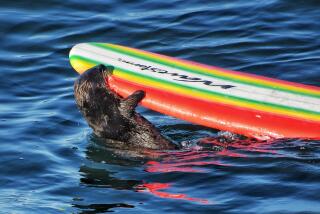Bluefin Came Back, but Where Is the Monster?
- Share via
We were talking about the return of bluefin tuna to our waters. Gerald McClellan was doing most of the talking because he had his fingers and tools in my mouth most of the time. Dentist McClellan is a veteran sportfisherman and had fished several times over the Cortez and Tanner banks, located 95 and 70 miles offshore respectively.
It is there that several anglers hooked up last fall with huge bluefin tuna, some weighing more than 100 pounds, and it is there that more anglers will be seeking a confrontation with these tackle-busters next month, when the legendary fighters are expected to return for a second year after half a century’s absence.
No, McClellan hadn’t caught any bluefin out there on the banks beyond San Clemente Island, but he had caught plenty of albacore, another fish that no longer frequents our waters near the shore in vast quantities.
“I think it’s the pollution that has driven the fish away. I know albacore are very sensitive to polluted waters,” he said, the screaming of his drill in my head making his words barely audible. I grunted my assent.
I wanted to tell him about the San Clemente monster, but I never made it. “Bite down on that,” he said, inserting something big and metal in my mouth with sticky goop on it. That effectively ended our conversation, such as it was.
The Clemente sea monster, the only monster I halfway believe in, is woven firmly in my memory of the past along with bluefin tuna, albacore and swordfish. The marlin and broadbill swordfish still visit the waters of the San Pedro Channel this side of Santa Catalina Island and beyond this to the Outer Santa Barbara Channel. But the bluefin and albacore generally have avoided these particular waters for about 50 years, whatever their reasons may be.
Some say it was the disappearance of the California sardine, disastrously overharvested by commercial seiners before and after World War II, that removed this vital link in the food chain the tunas feed upon. Small schools of sardines are coming back, which could account for the expected return of the great bluefin this fall in our outermost waters.
Old-timers recall that on a clear day in our San Pedro Channel, between Newport Beach and Catalina Island, you could spot a great advancing school of tuna, feeding on the surface, about two miles away, their huge sleek bodies rolling and leaping across the horizon, flashing blue and gold in the sun and sending up cataracts of spray.
The tuna were choosy about accepting an angler’s bait, usually a flying fish, and they were chary about striking at a bait trolled in the wake of a boat. It was Capt. George Farnsworth, whose name is carried on the bank, an ecological reserve today, nearly two miles southward of Ben Weston Point on the backside of Catalina, who devised the method of trolling the bait attached to a flying kite, made of red-dyed silk, about 100 yards away and off to the side of the boat. This was the method used by Zane Grey and other famous anglers of the 1920s.
It was the same Farnsworth, as familiar with these waters and the migrations of the fishes in them as he was with the back of his hand, who claimed to be the first person to sight the San Clemente sea monster between Catalina and San Clemente. He described the huge creature with a long neck as possessing “eyes 12 inches in diameter, not set on the side like an ordinary fish, but more central. It had a big mane of hair about two feet long.”
One of the Catalina Island Tuna Club’s famous members, George C. Thomas III, a sober, hard-fishing gentleman of the old school and not given to exaggeration, also reported seeing the monster. It was around 1924 or 1925, he reported, when he and Farnsworth, on the old Fairplay, spotted the monster again about eight miles off the coast of Clemente.
Dozens of monster sightings have been reported since then. The last report to my knowledge of a sighting was not off Clemente, but off Laguna Beach. It was related to me by Howard Wilson of that city, who, with his mother, sighted the monster cruising along smoothly, making no visible wake, about 400 yards off the Laguna coast. The monster was heading south, possibly to take up residence in Baja California, where it was less noisy than around Clemente, with its bombardments by the Navy, and where the forage was more abundant. That was 50 years ago.
I doubt if the monster, reputed to be a shy, solitary creature, will ever again be seen in these waters, in which turmoil has increased with bombardings, depth soundings and oil explorations, not to mention vast dumpings of sewage and poisonous chemicals, even though there is some evidence that the bluefin tuna and albacore may return moderately as the sardines begin to make their comeback.
The question is, will these great sportfish ever return in numbers between the mainland and Catalina? Are they simply waiting for man to clean up his oceanic act by showing some reverence and respect for the sea that laves his shores and nourishes him?
More to Read
Sign up for Essential California
The most important California stories and recommendations in your inbox every morning.
You may occasionally receive promotional content from the Los Angeles Times.










